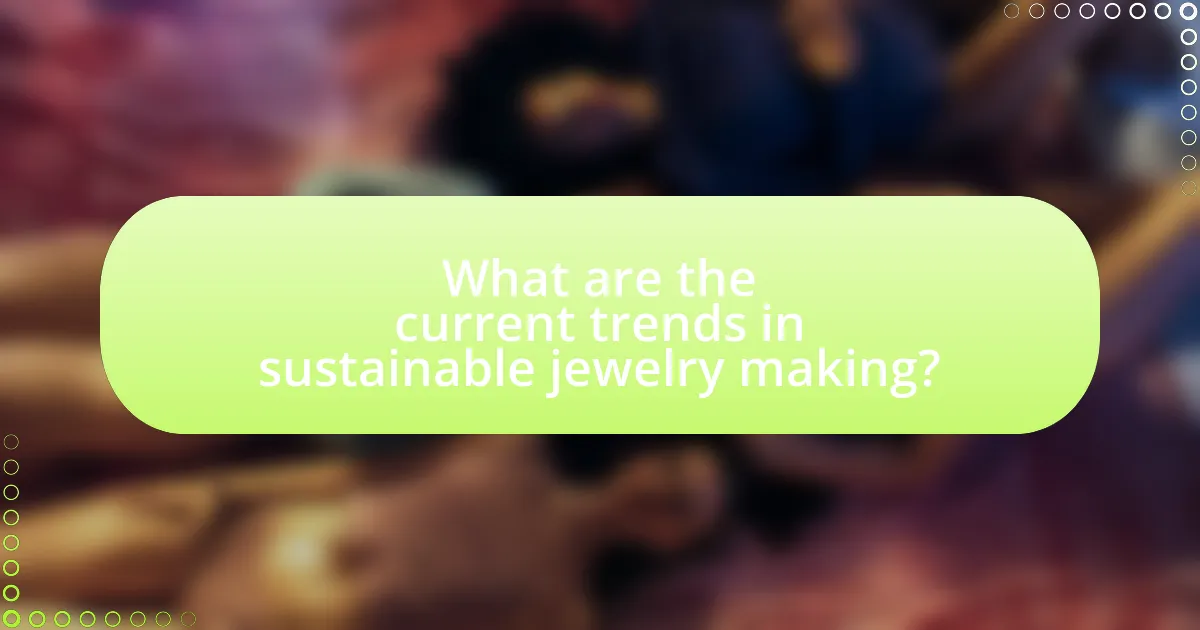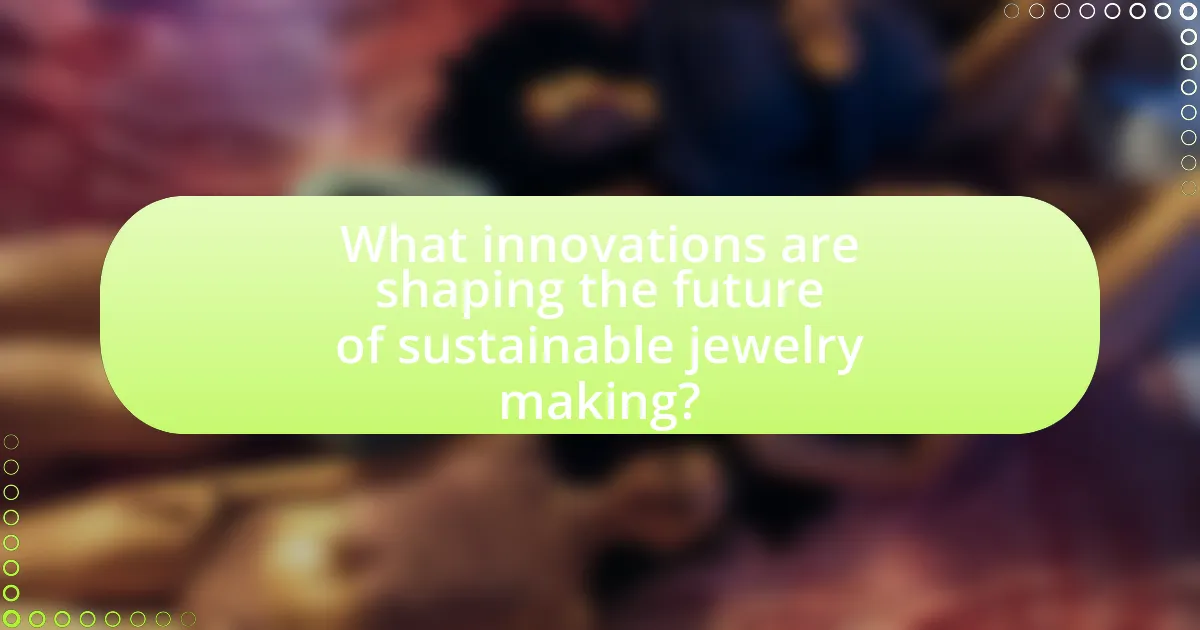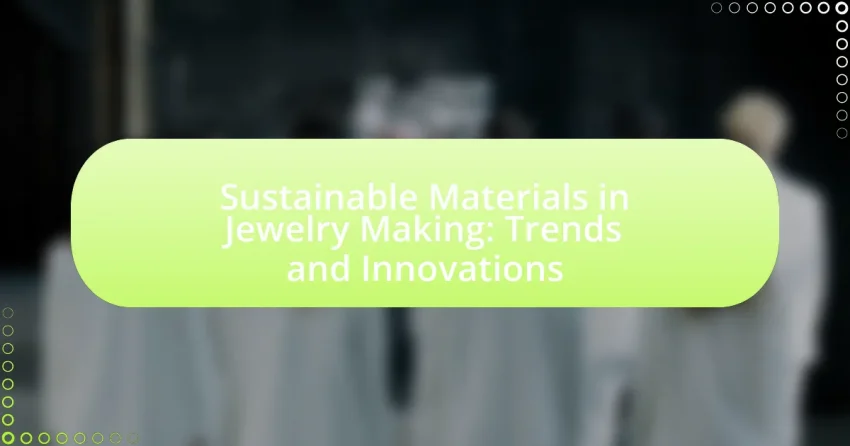Sustainable materials in jewelry making refer to eco-friendly resources that minimize environmental impact and promote ethical practices, including recycled metals, lab-grown gemstones, and biodegradable materials. The article explores the importance of sustainability in the jewelry industry, highlighting the environmental impacts of traditional practices and the influence of consumer demand on sustainable methods. It discusses various sustainable materials commonly used, the benefits of recycled metals, and the role of technology, such as 3D printing, in enhancing sustainability. Additionally, the article examines current trends, innovative techniques, and collaborations between brands and environmental organizations that are shaping the future of sustainable jewelry. Practical tips for consumers to support sustainable practices are also provided.

What are Sustainable Materials in Jewelry Making?
Sustainable materials in jewelry making are eco-friendly resources that minimize environmental impact and promote ethical practices. These materials include recycled metals, such as gold and silver, which reduce the need for mining and conserve natural resources. Additionally, lab-grown gemstones offer a sustainable alternative to mined stones, as they require fewer resources and have a lower carbon footprint. Organic materials like sustainably sourced wood, bamboo, and natural fibers are also utilized, providing biodegradable options. The use of these materials aligns with the growing consumer demand for responsible and transparent sourcing in the jewelry industry.
Why is sustainability important in the jewelry industry?
Sustainability is important in the jewelry industry because it addresses environmental and ethical concerns associated with mining and production processes. The extraction of precious metals and gemstones often leads to habitat destruction, pollution, and human rights violations, including labor exploitation. For instance, the World Gold Council reports that gold mining can result in significant ecological damage, while the Responsible Jewelry Council emphasizes the need for ethical sourcing to prevent human rights abuses. By prioritizing sustainable practices, the jewelry industry can reduce its ecological footprint and promote social responsibility, ultimately fostering consumer trust and loyalty.
What environmental impacts does traditional jewelry making have?
Traditional jewelry making has significant environmental impacts, primarily due to resource extraction, energy consumption, and waste generation. The mining of precious metals and gemstones often leads to habitat destruction, soil erosion, and water pollution, as seen in studies indicating that gold mining can produce up to 20 tons of waste for every ounce of gold extracted. Additionally, the energy-intensive processes involved in refining and crafting jewelry contribute to greenhouse gas emissions, exacerbating climate change. Furthermore, the use of toxic chemicals in the production process can contaminate local water supplies, affecting both ecosystems and human health.
How does consumer demand influence sustainable practices?
Consumer demand significantly influences sustainable practices by driving companies to adopt environmentally friendly methods and materials. As consumers increasingly prioritize sustainability, businesses in the jewelry sector respond by sourcing ethical materials, such as recycled metals and conflict-free gemstones, to meet market expectations. For instance, a 2021 survey by McKinsey & Company found that 67% of consumers consider sustainability when making purchasing decisions, prompting brands to enhance transparency and sustainability in their supply chains. This shift not only aligns with consumer values but also fosters innovation in sustainable materials, ultimately shaping industry standards and practices.
What types of sustainable materials are commonly used in jewelry making?
Commonly used sustainable materials in jewelry making include recycled metals, ethically sourced gemstones, and biodegradable materials. Recycled metals, such as gold and silver, reduce the need for mining and lower environmental impact. Ethically sourced gemstones, like lab-created diamonds and responsibly mined stones, ensure fair labor practices and minimal ecological disruption. Biodegradable materials, including wood and organic materials, offer an eco-friendly alternative to traditional options. These materials contribute to a more sustainable jewelry industry by minimizing resource depletion and promoting ethical practices.
What are the benefits of using recycled metals in jewelry?
Using recycled metals in jewelry significantly reduces environmental impact by minimizing the need for new mining, which is resource-intensive and harmful to ecosystems. Recycled metals require less energy to process compared to virgin materials, leading to lower carbon emissions; for instance, recycling gold can save up to 90% of the energy needed for extraction. Additionally, utilizing recycled metals supports a circular economy, promoting sustainability by reusing materials and reducing waste. This practice also often results in unique pieces, as recycled metals can carry historical significance and character, appealing to consumers who value individuality and ethical sourcing.
How do lab-grown gemstones compare to natural stones?
Lab-grown gemstones are chemically and physically identical to natural stones, but they are created in controlled environments using advanced technology. Unlike natural stones, which take millions of years to form, lab-grown gemstones can be produced in a matter of weeks, resulting in a more sustainable and ethical option. According to a report by the Gemological Institute of America, lab-grown diamonds, for instance, have the same optical and physical properties as mined diamonds, making them indistinguishable to the naked eye. Additionally, lab-grown gemstones typically have a lower environmental impact and are often more affordable than their natural counterparts, as they do not require extensive mining operations.

What are the current trends in sustainable jewelry making?
Current trends in sustainable jewelry making include the use of recycled metals, ethically sourced gemstones, and innovative materials such as lab-grown diamonds and biodegradable alternatives. The jewelry industry is increasingly prioritizing environmental responsibility, with a significant rise in brands adopting practices that minimize ecological impact. For instance, a report by the Ethical Jewelry Association indicates that 70% of consumers are willing to pay more for sustainable jewelry, reflecting a growing demand for transparency and ethical sourcing in the market. Additionally, advancements in technology have enabled the creation of synthetic materials that reduce the need for mining, further supporting sustainability efforts in the industry.
How are designers incorporating sustainable materials into their collections?
Designers are incorporating sustainable materials into their collections by utilizing recycled metals, ethically sourced gemstones, and biodegradable materials. For instance, many jewelry designers are now opting for recycled gold and silver, which reduces the environmental impact associated with mining new metals. Additionally, the use of lab-grown diamonds and gemstones sourced from conflict-free suppliers ensures ethical practices in sourcing. According to a report by the Ethical Jewelry Council, the demand for sustainable jewelry has increased by 30% over the past five years, indicating a significant shift towards environmentally conscious practices in the industry.
What innovative techniques are being used to create sustainable jewelry?
Innovative techniques used to create sustainable jewelry include the use of recycled metals, lab-grown gemstones, and 3D printing technology. Recycled metals reduce the need for new mining, thereby minimizing environmental impact; for instance, brands like Brilliant Earth utilize recycled gold and silver in their collections. Lab-grown gemstones, such as diamonds produced by companies like Diamond Foundry, offer a sustainable alternative to mined stones, as they require significantly less energy and water. Additionally, 3D printing allows for precise designs with minimal waste, enabling jewelers to create intricate pieces while conserving materials. These techniques collectively contribute to a more sustainable jewelry industry by reducing resource depletion and environmental harm.
How are brands communicating their sustainability efforts to consumers?
Brands are communicating their sustainability efforts to consumers through transparent storytelling, eco-labeling, and engaging digital content. For instance, many jewelry brands highlight the use of recycled materials and ethical sourcing practices in their marketing materials, showcasing certifications like Fair Trade or Responsible Jewelry Council. Additionally, brands utilize social media platforms to share behind-the-scenes processes and sustainability initiatives, fostering a connection with consumers who prioritize ethical consumption. Research indicates that 66% of global consumers are willing to pay more for sustainable brands, demonstrating the effectiveness of these communication strategies in appealing to environmentally conscious shoppers.
What role does technology play in sustainable jewelry making?
Technology plays a crucial role in sustainable jewelry making by enabling the use of eco-friendly materials and efficient production processes. Innovations such as 3D printing allow jewelers to create intricate designs with minimal waste, significantly reducing the environmental impact associated with traditional manufacturing methods. Additionally, advancements in sourcing technology, like blockchain, enhance traceability of materials, ensuring that gemstones and metals are ethically sourced. For instance, a study by the Responsible Jewelry Council highlights that technology-driven transparency can lead to a 30% increase in consumer trust regarding the sustainability of jewelry products.
How is 3D printing impacting sustainable practices in jewelry design?
3D printing is significantly enhancing sustainable practices in jewelry design by reducing material waste and enabling the use of eco-friendly materials. Traditional jewelry manufacturing often results in substantial waste due to the subtractive processes involved, whereas 3D printing utilizes additive manufacturing, which builds objects layer by layer, minimizing excess material. For instance, a study by the University of Cambridge found that 3D printing can reduce material waste by up to 90% compared to conventional methods. Additionally, 3D printing allows designers to experiment with sustainable materials, such as recycled metals and biodegradable polymers, promoting a circular economy in the jewelry industry. This shift not only conserves resources but also aligns with consumer demand for environmentally responsible products.
What advancements in material science are contributing to sustainability?
Advancements in material science contributing to sustainability include the development of biodegradable polymers, recycled metals, and lab-grown gemstones. Biodegradable polymers, such as polylactic acid (PLA), are derived from renewable resources and decompose naturally, reducing plastic waste. The use of recycled metals, like gold and silver, minimizes the environmental impact of mining and lowers energy consumption, as recycling requires significantly less energy compared to extraction. Lab-grown gemstones, produced through controlled processes, offer a sustainable alternative to mined stones, reducing ecological disruption and resource depletion. These innovations collectively enhance the sustainability of materials used in jewelry making.

What innovations are shaping the future of sustainable jewelry making?
Innovations shaping the future of sustainable jewelry making include the use of lab-grown gemstones, recycled metals, and biodegradable materials. Lab-grown gemstones, such as diamonds and sapphires, reduce the environmental impact associated with mining and provide a conflict-free alternative. Recycled metals, sourced from old jewelry and electronic waste, minimize the need for new mining operations, thereby conserving natural resources. Additionally, biodegradable materials like plant-based resins and sustainable wood are being integrated into designs, offering eco-friendly options that decompose naturally. These innovations collectively contribute to a more sustainable jewelry industry by addressing environmental concerns and promoting ethical practices.
What are the emerging materials that could revolutionize the industry?
Emerging materials that could revolutionize the jewelry industry include lab-grown diamonds, recycled metals, and bio-based polymers. Lab-grown diamonds, which are chemically identical to natural diamonds, offer a sustainable alternative with a significantly lower environmental impact, as their production requires less energy and water compared to traditional mining. Recycled metals, sourced from old jewelry and electronic waste, reduce the need for new mining and help minimize ecological damage. Bio-based polymers, derived from renewable resources, provide innovative options for sustainable design while maintaining durability and aesthetic appeal. These materials not only address environmental concerns but also cater to the growing consumer demand for ethical and sustainable products in the jewelry market.
How are bioplastics being utilized in jewelry design?
Bioplastics are being utilized in jewelry design as eco-friendly alternatives to traditional materials, allowing designers to create sustainable pieces that reduce environmental impact. These materials, derived from renewable sources like cornstarch or sugarcane, can be molded into intricate shapes and colors, enabling innovative designs while maintaining biodegradability. For instance, brands such as “Pola” and “Marta” have successfully incorporated bioplastics into their collections, showcasing the versatility and aesthetic appeal of these materials. This shift towards bioplastics aligns with the growing consumer demand for sustainable fashion, as evidenced by a 2021 survey indicating that 66% of global consumers are willing to pay more for sustainable products.
What potential do alternative materials hold for the future of jewelry?
Alternative materials hold significant potential for the future of jewelry by offering sustainable, ethical, and innovative options that appeal to environmentally conscious consumers. These materials, such as lab-grown diamonds, recycled metals, and bio-based alternatives, reduce the environmental impact associated with traditional mining and production processes. For instance, lab-grown diamonds have the same physical and chemical properties as natural diamonds but are produced with a significantly lower carbon footprint, making them a more sustainable choice. Additionally, the use of recycled metals can decrease the demand for new mining, which is often associated with ecological degradation. The growing trend towards sustainability in consumer behavior further supports the adoption of these alternative materials, as evidenced by a 2021 survey indicating that 66% of global consumers are willing to pay more for sustainable brands.
How are collaborations influencing sustainable jewelry innovations?
Collaborations are significantly influencing sustainable jewelry innovations by combining expertise from various sectors, leading to the development of eco-friendly materials and practices. For instance, partnerships between jewelry designers and environmental organizations have resulted in the creation of collections that utilize recycled metals and ethically sourced gemstones, thereby reducing the environmental impact of jewelry production. A notable example is the collaboration between the luxury brand Chopard and the Fairmined initiative, which promotes responsible mining practices, ensuring that the gold used in their jewelry is sourced sustainably. This synergy not only enhances the credibility of sustainable practices but also drives consumer awareness and demand for ethically produced jewelry, as evidenced by a 2021 survey indicating that 66% of consumers are willing to pay more for sustainable products.
What partnerships are forming between brands and environmental organizations?
Brands are increasingly forming partnerships with environmental organizations to promote sustainability in jewelry making. For instance, companies like Brilliant Earth collaborate with organizations such as the World Wildlife Fund to ensure responsible sourcing of materials and to support conservation efforts. These partnerships often focus on initiatives like reducing carbon footprints, promoting ethical mining practices, and enhancing recycling programs. Such collaborations are validated by the growing consumer demand for transparency and sustainability, with a 2021 survey indicating that 66% of global consumers are willing to pay more for sustainable brands.
How do these collaborations enhance consumer awareness and engagement?
Collaborations in sustainable jewelry making enhance consumer awareness and engagement by combining the expertise and reach of multiple brands or organizations. These partnerships often lead to co-branded campaigns that highlight the importance of sustainability, thereby educating consumers about eco-friendly materials and practices. For instance, when a well-known jewelry brand collaborates with an environmental organization, it can leverage the organization’s credibility to inform consumers about the environmental impact of traditional materials versus sustainable alternatives. This approach not only raises awareness but also fosters a sense of community and shared values among consumers, encouraging them to engage more deeply with the brand and its mission.
What practical tips can consumers follow to support sustainable jewelry practices?
Consumers can support sustainable jewelry practices by choosing ethically sourced materials, such as recycled metals and conflict-free gemstones. Ethically sourced materials reduce environmental impact and promote fair labor practices. Additionally, consumers should research brands for their sustainability certifications, such as Fair Trade or Responsible Jewelry Council membership, which indicate adherence to ethical standards. Supporting local artisans who use sustainable practices also contributes to reducing carbon footprints associated with transportation. Lastly, opting for vintage or second-hand jewelry extends the lifecycle of existing pieces, minimizing the demand for new resources.
